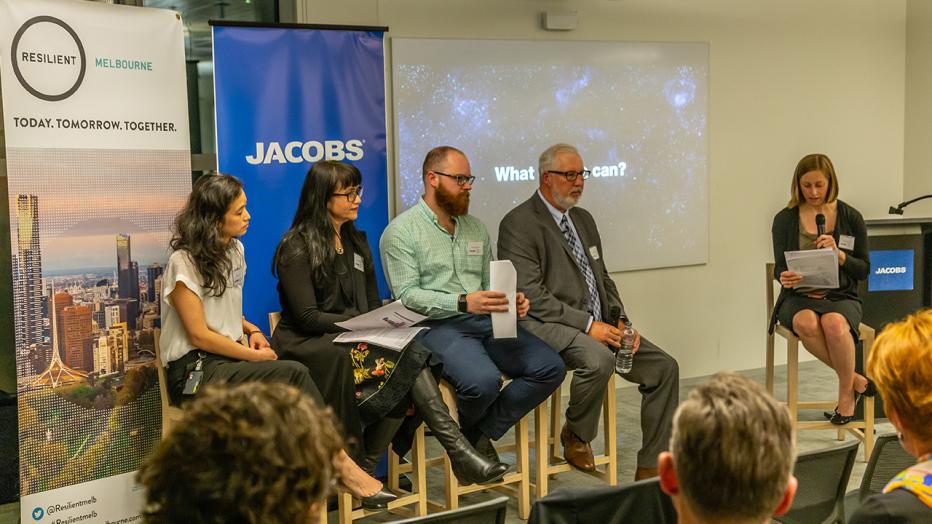
Jacobs has been fortunate to partner with Resilient Melbourne in the delivery of a series of three events focusing on Emerging Technologies for Resilient Cities. The first event focused on the theme “Survive” and explored how large-scale 3D printing technology being developed for NASA might be applied to solve problems here on earth. The second of these events focused on the theme “Adapt,” with the keynote presentation delivered by Jacobs’ Global Solutions Director for Resilience and Water Resources Adam Hosking –. His presentation focused on how climate vulnerability modelling technologies could be used to project future climatic scenarios in Melbourne and how the city might plan accordingly.
Melbourne is currently facing a range of challenges brought about by rapid population growth putting pressure on ageing infrastructure, the quality of the environment and available resources. These challenges are further amplified by emerging environmental stresses such as sea level rise, coastal flooding, drought and diminishing water resources, and increased shocks from extreme weather events. This period of continuing population growth has been followed by a surge in infrastructure investment—the state of Victoria is embarking on an extensive infrastructure development program with over AUD $100 billion worth of projects currently planned or being built. The projects being planned now will shape the city for the next 50 years, so, now is the time to lay the right foundation for a more resilient future.
In his presentation Adam shared a simple yet powerful model that illustrates how knowledge (technology), rules (policy) and values must come together to drive innovation and resilience.
This concept was explored further in the subsequent panel discussion which comprised specialists from policy, insurance and social equity backgrounds. The unanimous conclusion was that we often have the knowledge and we are working on the rules, but we struggle with the values, and as a result, some of our most vulnerable communities end up being underrepresented in climate adaptation plans.
So, the question is: how can we better incorporate values into city planning decisions?
Putting people at the heart of decision-making with a focus on inclusive growth
For a long time, infrastructure investment decisions were guided by time, cost and quality considerations. Over the last 20 years, additional considerations such as safety and pollution, and more recently, environmental sustainability, have been incorporated into the decision-making process.
When it comes to responding to climate adaptation, investment decisions have historically been focused almost exclusively on measures to avoid damage to existing infrastructure and related assets. The value of a proactive approach was illustrated by Adam’s case study on New York City’s response to Hurricane Sandy. For the work he had been involved in, every dollar spent on climate adaptation provided an 8:1 return on investment. However, this was a conservative estimate; the calculations didn’t measure the minimizing impact of proactive and targeted climate adaptation investment on factors such as loss of productivity, community upheaval and other metrics of societal well-being, therefore underestimating the full benefits of proactive climate adaptation spend.
In a new era of public policy making, we’re beginning to realize that economic growth should not be the sole objective, focus or driver for policy makers. Rather, economic growth should be viewed as a vehicle for enabling people and places to fulfil their potential, with the ultimate objective of increasing societal wellbeing. This requires an integrated approach to economic and social policy at all levels of government, as well as new platforms and shared budgets to facilitate the task.
To achieve this, we must adopt a more inclusive growth model that ensures everyone can participate in growth and benefit from it. We must broaden our perspective of success and measures of progress to better recognize social and community value alongside economic value. Focusing on social value will force us to seek opportunities to improve community wellbeing in addition to providing vital economic benefits (e.g. job creation etc).
Jacobs recognizes the difficulties in shifting our thinking to an inclusive growth mindset, and the associated challenges around measurement and quantification of potential and actual value. Over the last year, our economists have been working in partnership with other leaders in social value impact assessment, wellbeing and ethics to help address this challenge, developing a standardized approach using tools, such as the Social Value Bank Supply Chain Models and Value by Design Framework. These resources provide a method and approach for social value and ethics - both in terms of setting the strategy (for the public and private sector) and quantifying the impact, thus facilitating the values case in Adam’s resilience model.
Jacobs thanks Resilient Melbourne for the opportunity to collaborate on this series and contribute to conversations that matter.
About the author
As Chief Technical Director for Jacobs’ Buildings and Infrastructure business across the Asia Pacific Region, Nick Robinson is firmly focused on transforming culture, driving innovation in winning work, building the external profile of the business and its technical leaders and using the global and regional expertise of the business to underpin future growth.












































